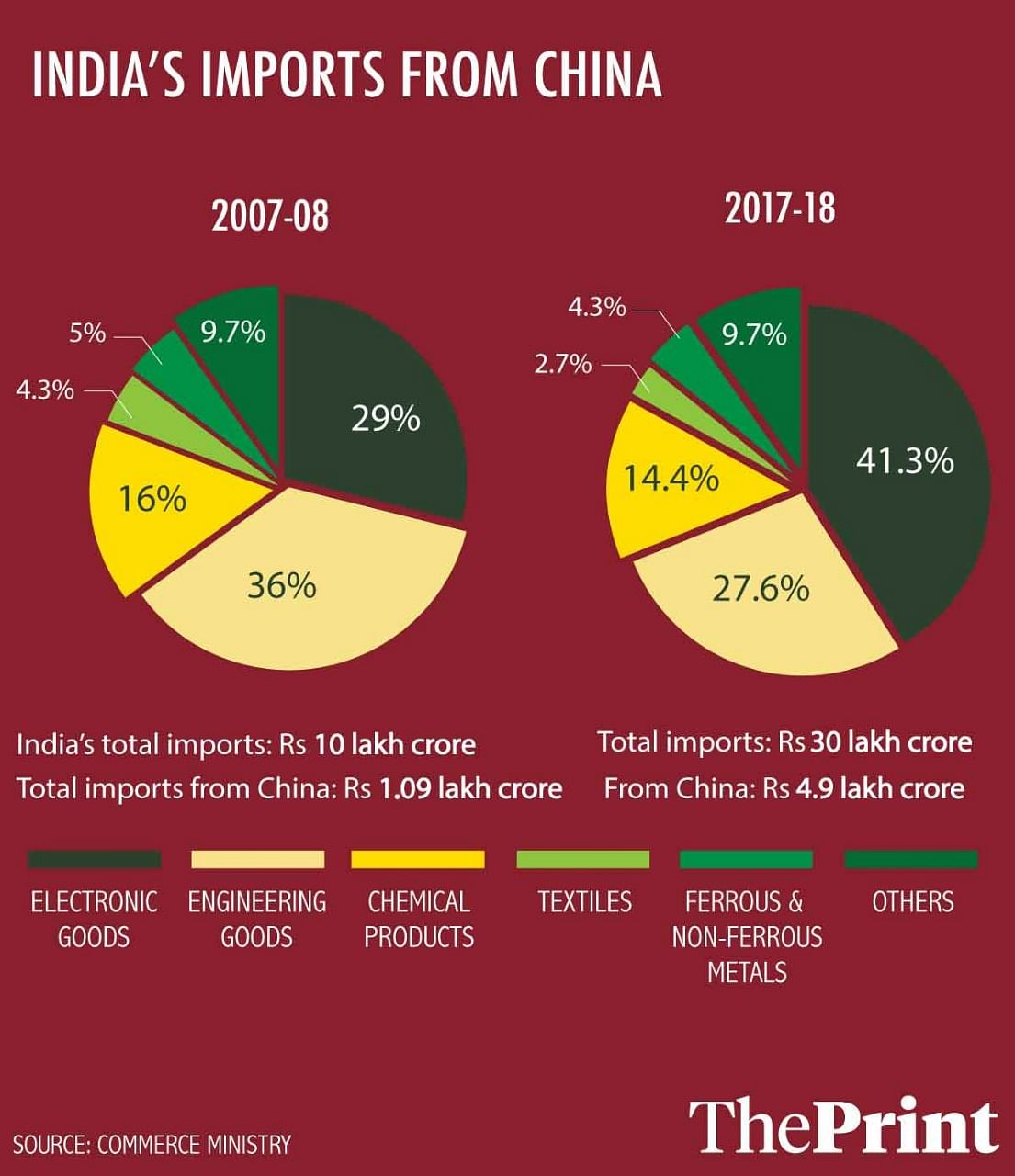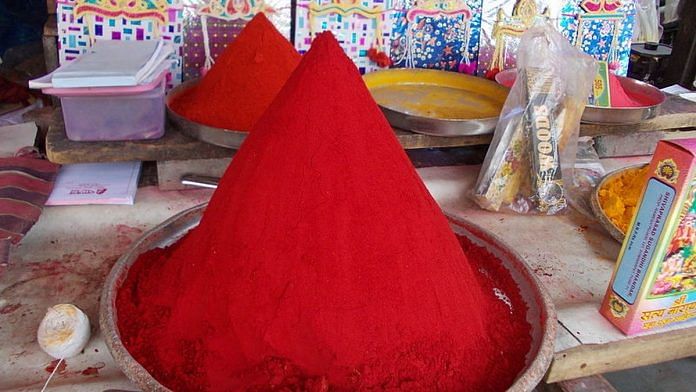New Delhi: From the sindoor women apply to the Kolhapuri chappals that have kept the eponymous Maharashtra district on the fashion map for decades.
From the children’s books your kids read to sleep, to the papad you serve with dinner tonight. Even the clothes with striking Kalamkari work, a craft with roots in India’s south, or Bihar’s popular Madhubani patterns that you found for a steal online.
From makeup and jewellery, to wigs, dolls, children’s books, and plastic furniture: You name an item used around the household and chances are it will be ‘Made in China’.
Chinese goods are flooding Indian households and meeting even their most basic needs, making inroads into areas hitherto considered a domestic preserve: From the kantha embroidery craft, to lungis, dhotis, and zari saris.
And it’s not just in urban areas: Chinese goods, be it stationery or toiletries, have increasingly become fixtures in kirana (grocery) shops around rural areas well.
Although these products form a small share in India’s overall imports from China, they signal the country’s growing dependence on cheap Chinese imports that eat into the market share of small-time domestic businessmen.
India imports more than 8,000 types of items from China, going by the eight-digit HSN code used to classify traded items.
India’s total imports were worth more than Rs 32 lakh crore in the 10 months ending January 2019, as against Rs 30 lakh crore in the entire 2017-18 fiscal. Of this, imports from China were at Rs 4.2 lakh crore in 10 months ending January in 2018-19 and Rs 4.9 lakh crore in 2017-18.
In most of the years of the Narendra Modi government, China’s share in total Indian imports has been around 16 per cent.
“China has excelled in manufacturing items of mass consumption at a cheaper cost,” T.S. Vishwanath, a principal adviser at APJ-SLG Law Offices who specialises in trade matters, told ThePrint.
“China has been able to take over markets completely because of two reasons — they research the market thoroughly to figure out what are the items in demand, and are then able to produce them on a large-scale to minimise costs,” he added.
“In contrast, in India, these items are produced by small and micro enterprises which do not have the capacity to produce these items at a lower cost, or penetrate the market like Chinese products can,” Vishwanath said.
He added that these items are sold to people who are price-sensitive, and as such immune to the calls to boycott Chinese products that erupt every now and then, especially during times of strain in bilateral ties.
“They [price-sensitive buyers] won’t be nationalistic to say that they will use only Indian-manufactured products,” Vishwanath said.
According to Chandrakant Salunkhe, the president of the SME (small & medium enterprises) Chamber of India, the price differential between Chinese imports and locally-produced items is at least 25 per cent, and this is true even for a low-cost small item.

Also read: Traders can’t boycott cheap Made in China products because very little is made in India
Racquets and phones
Since China joined the World Trade Organisation, which regulates trade between nations, in 2001, India’s imports from the country have risen at a galloping pace — from Rs 0.13 lakh crore in 2002-03 to Rs 1.09 lakh crore in 2007-08 and Rs 4.9 lakh crore in 2017-18. China’s share in total Indian imports has also risen from 4.5 per cent in 2002-03 to 10.7 per cent in 2007-08 to 16 per cent in 2017-18.
More than 96 per cent of India’s Chinese imports in 2017-18 were manufactured goods — an industry where China has stolen a big march over India.
The major imports include engineering goods, electronic items like mobile phone components, and chemical products, which together made up more than 83 per cent of India’s imports from China in 2017-18.
Imports of telecom instruments have also doubled in the last five years, reflecting the growing number of Chinese mobile phone manufacturers setting up assembling units in India. Textiles and metals comprise some of the other major imports.
The sports goods and equipment imported primarily include chess sets, carrom boards and badminton racquets and shuttlecocks.
Ajai Sahai, the director general and CEO of Federation of Indian Exports Organization, said that while China had been able to offset labour wage increases with better productivity, India had not.
“China has been able to manage economies of scale that India has not been able to replicate,” he told ThePrint.
“We also need to… It is the need of the hour. We also need to develop standards for both domestic manufacturing and imports, so that sub-standard imports are not dumped in India,” he said.
Also read: Want ‘Make in India’ only — Ahmedabad taxman rants against Chinese water bottles







1. Our importers import goods from China and earn profits. Obviously, they are unconcerned about impact of imports on our manufacturing sector. 2. We are also aware of Chinese international trade clout and even USA and EU countries are unable to find out how China is able to export goods at such low prices. 3. Considering China’s huge trade surpluses, it is not surprising that China wishes that free trade should continue. China is the biggest beneficiary of free trade during the last three decades or so. It is also perhaps the only country which has finessed the art of giving hidden subsidies and blocking imports from countries to which it exports and earns billions of dollars. 3. Everyone is aware that China is a communist country with zero transparency. It is time the entire democratic world with which China has all kinds of trade issues gears to face the ugly trade tactics of China.